Guest post by Daniel Gosling and Charlotte Smith, 12 October 2023.
In June 2023, The National Archives (UK), generously supported by The Journal of Legal History/Taylor & Francis and British Online Archives, hosted the inaugural Legal Records Jamboree, showcasing legal records from across their collections. A variety of people and groups attended the day, and speakers gave 5-minute presentations on their chosen document before showing off the record in more detail in the Map and Large Document Reading Room at Kew.
In this four-part blog series, Dr Daniel Gosling and Dr Charlotte Smith, Legal Records Specialists at The National Archives, provide an overview of the documents on show during the day and reflect on the different types of legal record held at The National Archives.
This first blog examines records relating to pleadings.

For the medieval and early modern common law courts, pleadings are preserved in the plea rolls, which recorded the stages of each case. The plea rolls of the court of King’s Bench (modern series reference KB 27) recorded the business of this superior court from 1273 until 1702, when the Crown side and plea/civil side were split into separate rolls (Crown side in KB 28, plea side in KB 122). These rolls comprise hundreds of rotuli which list cases heard by the court. A typical plea roll entry will recite the terms of the writ, then detail the plaintiff’s claim, the defendant’s plea, and can also include the plaintiff’s replication (the response to the plea) and the defendant’s rejoinder (the response to the replication).
Pleadings were the formal written documents by which parties set out their dispute. Though the documents were created differently depending on which legal system parties were using, the purpose of the pleadings remained the same: to ascertain the precise wrong that had allegedly been committed, so that the court could make a judgment. As the repository of the central law courts in England and Wales (then Britain), The National Archives holds hundreds of thousands of legal records relating to pleadings from the medieval period onwards, a small sample of which was on display for the Legal Records Jamboree.
As well as being important for preserving the thousands of cases heard by the court over the centuries, the medieval and early modern plea rolls could also include portraits of the monarch. For the jamboree, KB 27/1028, the plea roll for Trinity Term in 1518 (10 Hen VIII) was displayed, with its portrait of Henry VIII on the title rotulus.
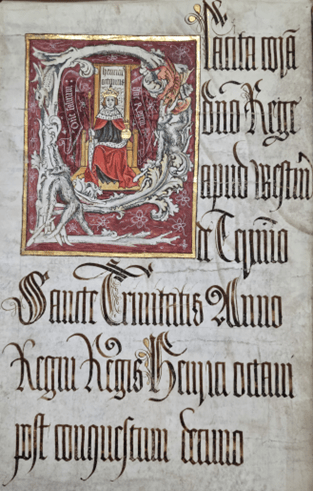
These pleadings were preceded by the indictment, the formal document setting out the charges against the defendant. For the court of King’s Bench, these records are held at The National Archives in series KB 9 to KB 12. Centuries later, this process of producing indictments to begin criminal proceedings remained the same, even if the courts changed. The indictments filed at the Central Criminal Court (the Old Bailey) between 1834 and 1971 are held in CRIM 4. By the modern period in particular, indictments are often dismissed as brief and formulaic, though they can contain a wealth of valuable information. For the jamboree, the 1948 indictment against Robert Lawrence and Dennis Malcolm King (CRIM 4/1758) showed us the value of these records. Lawrence and King were charged under the 1916 Larceny Act for obtaining £750 from Hyman Aarons by falsely claiming that they were the owners of three specified vehicles, an Austin and two Morris Motor Cars (licence plate numbers provided). Handwritten notes at the top of the indictment reveal that the case was twice postponed, before it was finally heard in June 1948, and that both defendants pleaded guilty, were sentenced to periods of penal servitude or imprisonment, and that a total of eleven other charges were taken into consideration. The back of the indictment includes the names of counsel for the prosecution and the names of six witnesses, including the victim.
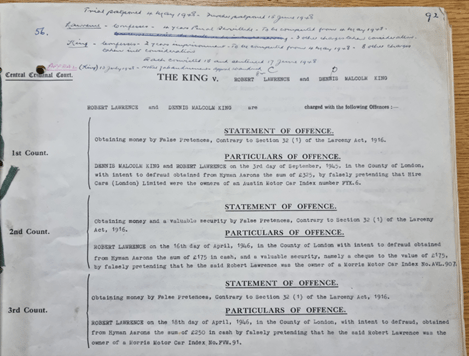
The surviving records of many criminal cases heard at the central law courts or assize courts are held at The National Archives, but not all. Some courts operated under a separate jurisdiction and their records are held elsewhere. Criminal cases for the city of London and Middlesex are one example, heard at courts such as the Old Bailey, and so the bulk of these records are instead at the London Metropolitan Archives (and the printed proceedings are searchable on Old Bailey Online).
However, papers at The National Archives can supplement this material. The records of the Treasury Solicitor (TS) are a treasure trove of papers relating to legal proceedings. For the jamboree, the papers relating to the 1742 case Rex v William Bird (TS 11/894/3042) were displayed, complementing the sessions of the peace records for London and Middlesex where the case was heard. Bird stood accused of imprisoning twenty people in a small room called the Hole, which resulted in the deaths of three women. The Treasury Solicitor’s papers provide specific details of this wretched scene.
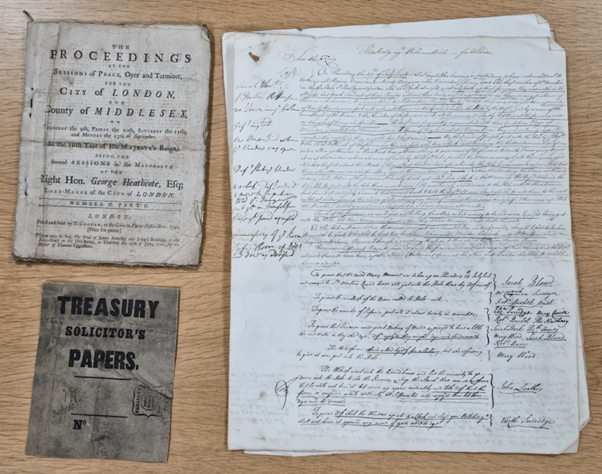
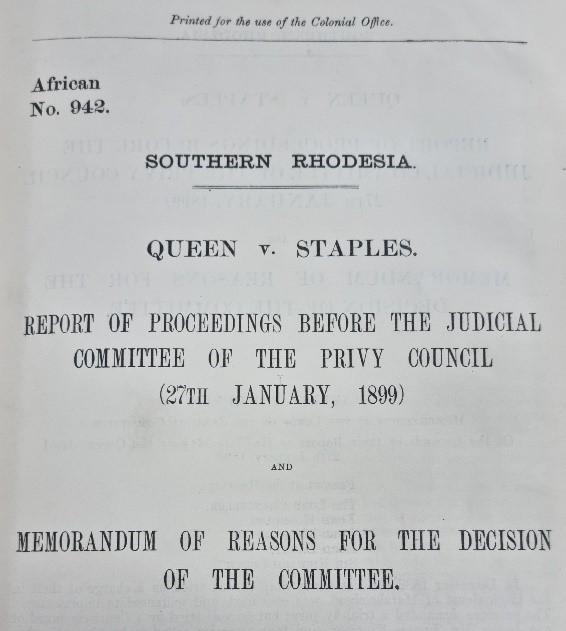
The Treasury Solicitor’s papers aren’t the only collection at The National Archives that can supplement or fill in gaps in the formal legal record. CO 879 contains Colonial Office confidential prints for Africa in the period 1848 to 1970. The 1899 report chosen for the jamboree, CO 879/103/2, describes the proceedings before the Judicial Committee of the Privy Council in Southern Rhodesia, Queen v Staples, together with a memorandum explaining the reasons for the decision of the Committee. The case is unreported, and proceedings are not included in the main Privy Council Appeal Papers (PCAP 6), which do not typically include reports relating to applications for leave to appeal. Yet such proceedings are often significant as they can shed light on imperial policy and practice at a given point in time.
The documents created by the equity and conciliar courts differed from those of the common law courts. Bills of complaint, answers, replications, and rejoinders, which formed the pleadings of these courts, were created and preserved as separate documents. In bills of complaint, we can often get a sense of the individual behind the legal proceedings, compared to the sometimes impersonal pleadings of the common law courts. In REQ 2/8/175, a Court of Requests bill of complaint from the reign of Henry VIII, we learn not only of Richard Aungern’s complaint against the bailiff to the Archbishop of Canterbury, but also of his impotence through the “debility and feebleness of old age”. In this matter, the Court of Requests’ place as a court of poor men’s causes was a literal one, as Aungern repeatedly refers to himself as a “poor orator”.
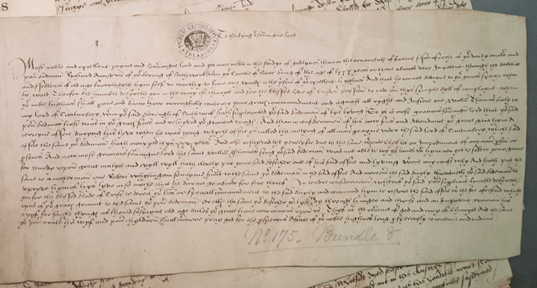
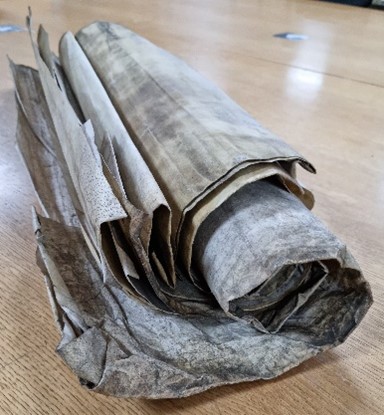
For the court of Chancery, the premier equity court in the realm, pleadings are collected in series C 2 to C 18. The court was used by all walks of life, from labourers and bricklayers to peers of the realm, and so these records can provide details of people not found in common law records. C 11/641/20, on display at the jamboree, tells the 1715 story of Mary Bangs, complainant in a case against her estranged husband John Bangs. This case was notable because Mary Bangs described herself in the bill of complaint as “the unhappy wife of John Bangs”, giving us an insight into Mary’s grievance before we even get to the crux of her complaint.
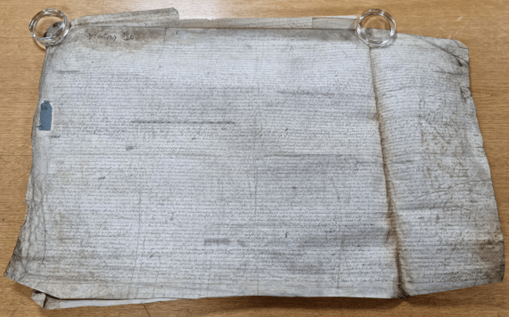
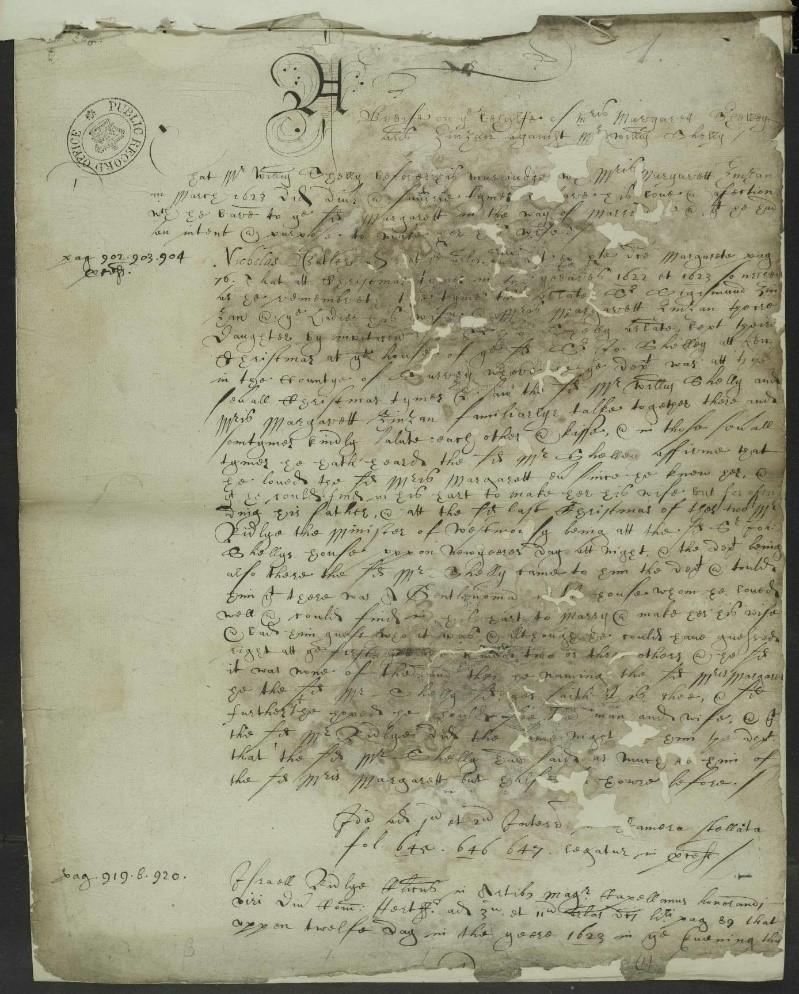
Another unhappy wife was described in relation to a lost Star Chamber case. The pleadings for the court of Star Chamber (STAC), along with the proofs, form the bulk of the surviving material for this early modern conciliar court, which at its height could hear some of the most serious criminal cases, including murder. A great tragedy of the Star Chamber archive is that it’s incomplete. The entry books of decrees and orders, which would have recorded verdicts, and the pleadings for the reign of Charles I, have been lost, separated from the rest of the pleadings in the early seventeenth century and lost by the end of that century. As such, researchers must piece together Star Chamber cases from other sources. SP 16/256 contains one such source, a brief on behalf of Margaret Shelley alias Zinzan. The lengthy brief contains particulars of the case, concerning the validity of Shelley’s marriage to William Shelley, disputed because it was claimed that William was intoxicated at the time of its celebration.
By the modern period, records of pleadings can be found as part of case files. The files of the Divorce and Matrimonial Causes Court, and later the Probate, Divorce and Admiralty Division of the High Court, contain a wealth of material of potential interest to social and legal historians, biographers and family historians. As well as pleadings, these records can also contain copies of marriage certificates and photographs. J 77 holds an almost complete set of case files between 1858 and 1927, and an 80% sample of case files for the period 1928 to 1937. Very few files survive for cases after 1937. J 77/200/5324, on display during the jamboree, contains the files for the 1877 divorce case between the 7th Earl and Countess of Aylesford. The co-respondent was George Charles Spencer-Churchill, Marquess of Blandford, the father of the Countess’s illegitimate son.

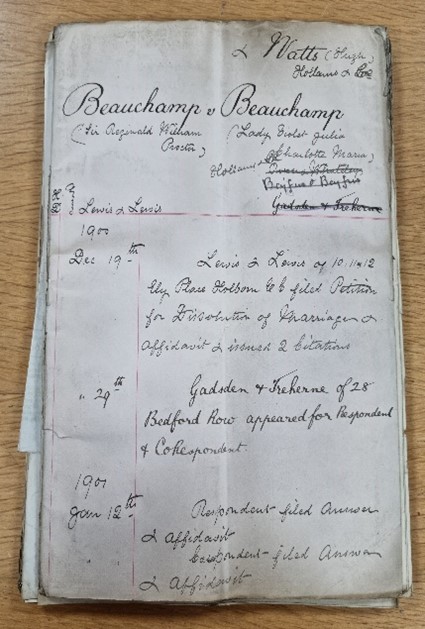
Another divorce file on display was J 77/708/1523, the divorce petition brought by Sir Reginald William Proctor Beauchamp against his wife, Lady Violet Julia Charlotte Maria Beauchamp. The co-respondent was the city financier and former politician, Hugh Watt, with whom Lady Violet had been conducting a much-publicised affair. The divorce was granted, and Watt’s wife also successfully secured a divorce on the grounds of adultery and cruelty. When she refused to finalise the divorce, Watt apparently tried to procure her death and consequently was sentenced to a period of penal servitude. Upon his release, he and Lady Violet were married.
Through the pleadings, researchers can glean a huge amount of information. Regardless of when a case was heard or which court heard it, the pleadings will, at the very least, inform us what matter was in dispute, and the opinions of the key parties regarding this matter. For some time periods and courts, however, this is all that the pleadings can tell us, and we need to look elsewhere for records of the next stages in the case. The focus of the next blog will be on one of these stages, the proofs, the part of the case where the court, having ascertained what was in dispute, tried to find out which party was in the wrong through witness statements and evidence.
Documents selected by Sean Cunningham, Bob Shoemaker, Tim Hitchcock, Michael Lobban, Laura Flannigan, Emily Ireland, Ian Williams, Catharine MacMillan, and Jennifer Aston.
If you have a question about the Legal Records Collections held at The National Archives, Dan and Charlotte welcome enquiries from interested researchers.
All documents © The National Archives. Photos taken by Dan Gosling.